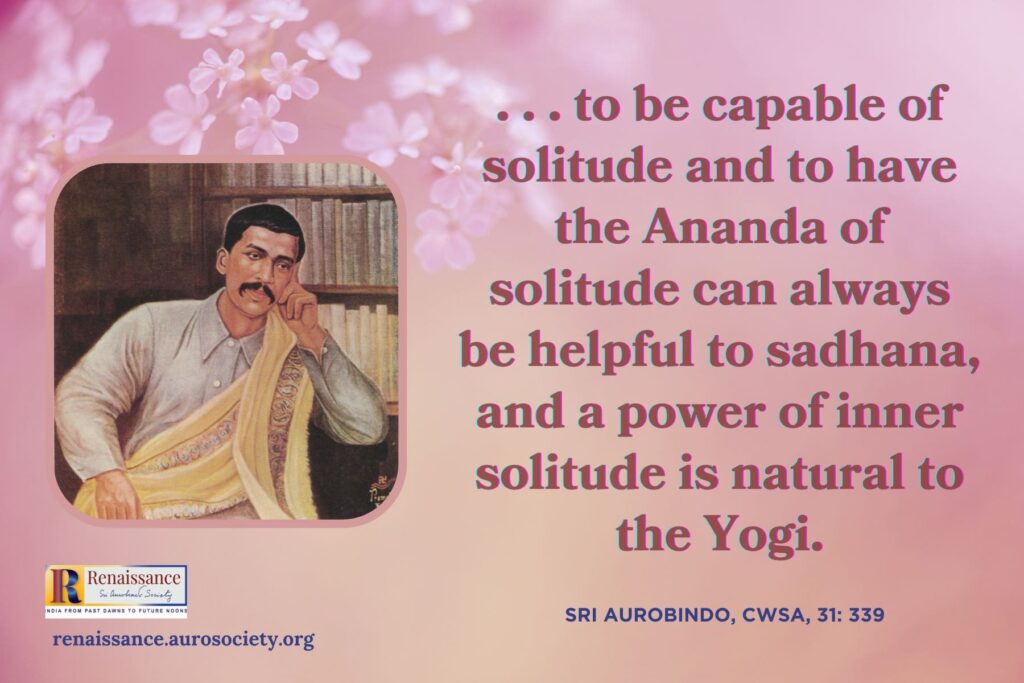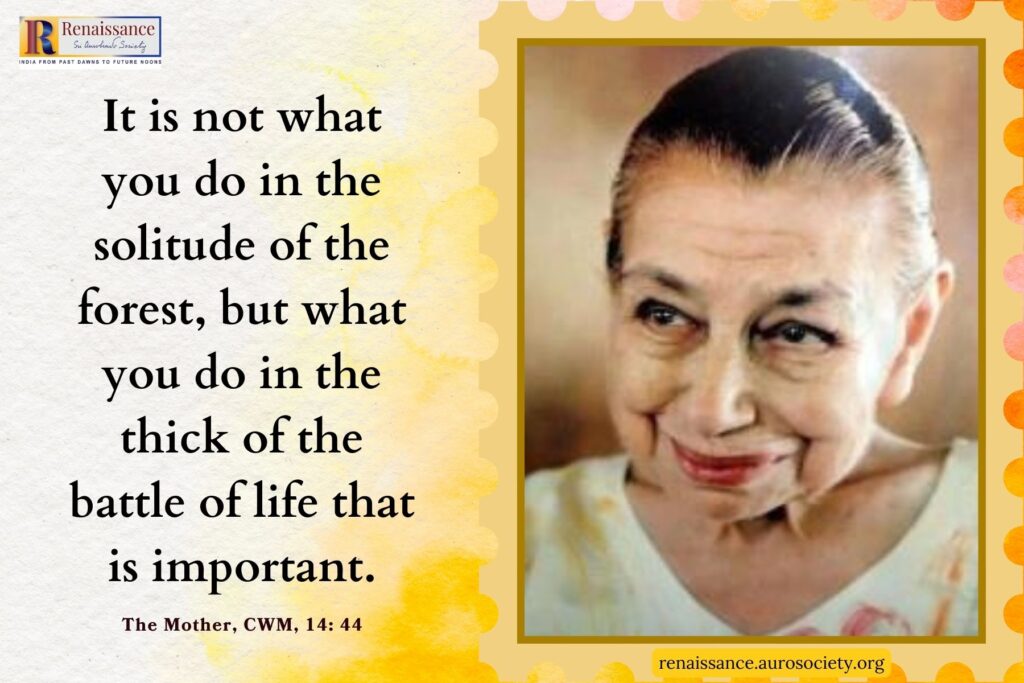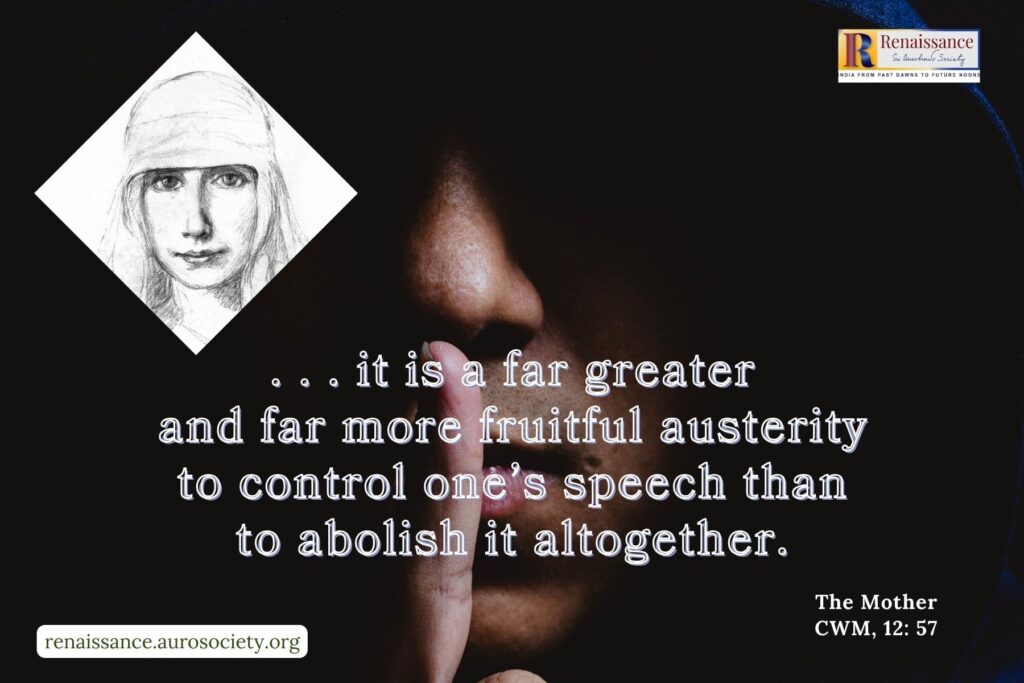A single occupation, a single aim, a single joy―the Divine.
– The Mother, CWM, Vol. 14, p. 14
This is how the Mother guides us — most simply, and most profoundly. To be even slightly worthy of this term ‘sādhaka’, one must have this — one single occupation, one single aim, one single joy – the Divine. Nothing more. Nothing less.
But this requires the most sincere aspiration. It requires an absolutely perfect surrender, and a most rigorous rejection of all that takes one away from that single occupation and single aim. It requires deep and perfect concentration of all our energies, all our thoughts and emotions, every single movement within and without.
The path is long. But Her Grace can make it sweet and sunlit.
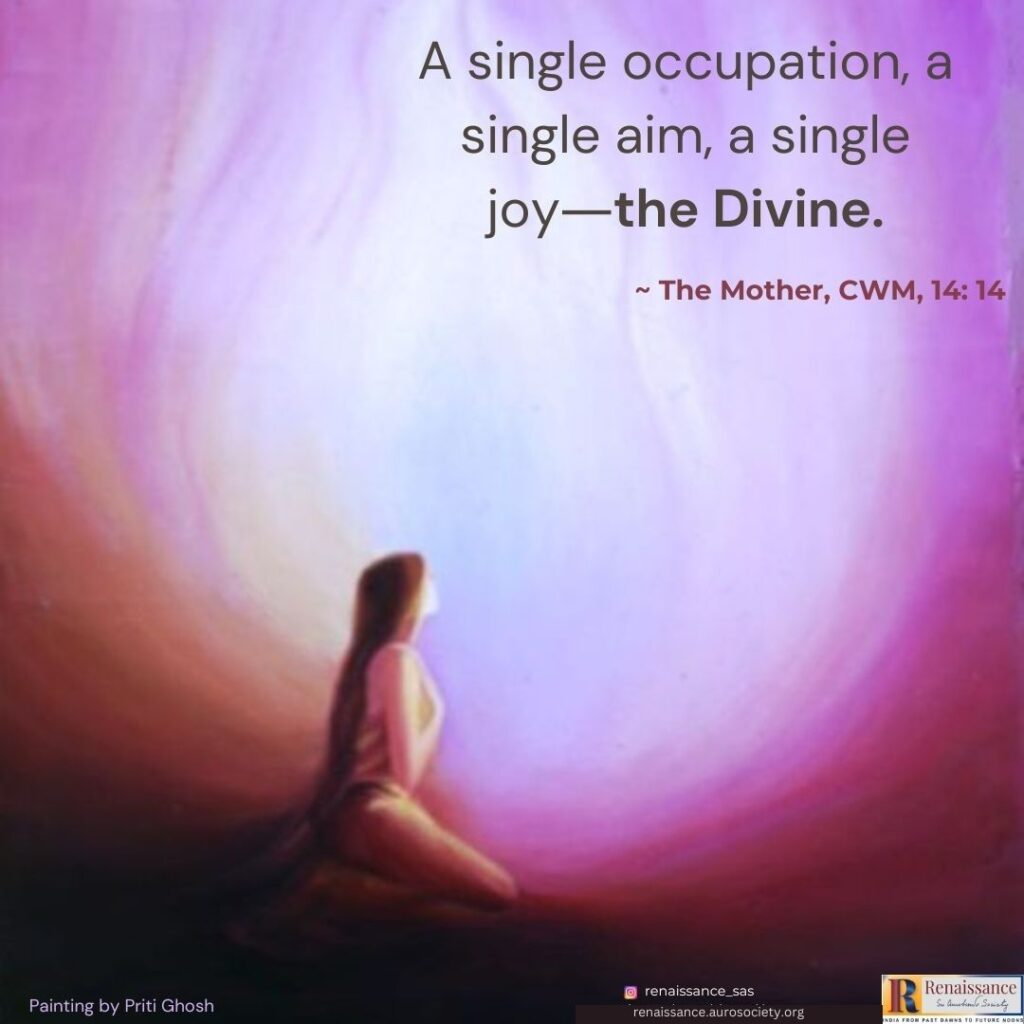
Sri Aurobindo once said that it is a mistake to think that one can do Yoga on one’s own. No human being can ever do it. It is always the Divine who does the Yoga. Our job is to give full assent to the Divine. There is so much hope and optimism in this thought. Though, of course, even giving our full assent to the Divine Will does not come without challenges.
Most of us – products of modern upbringing and educational experience – have grown up with somewhat confused and confusing ideas of individual agency and self-reliance. We have been more or less conditioned to “make things happen.” Or if not that, at least do things “our way” because we think we know what is good for us.
No wonder, it is not easy for such minds and vitals to let go and give assent to the Divine Will. Especially, when we don’t even know what is Divine Will. That makes things more difficult. This is why we have to constantly call for the Mother’s help. Pray for Her grace, guidance and light.
Sri Aurobindo reminds us that in Integral Yoga what matters most is the inner relation we build with the Mother. Because She is the path and the goal. He writes in a letter that the “embodied Mother must be the foundation of the concentration” (CWSA, Vol. 32, p. 52). I have found great help in this advice. Over the years I have learned that often by starting an inner dialogue with the Mother, I begin to get closer to Her. This is my way of concentrating on Her. I tell her all that may be bothering me at that moment, and I ask for her help. I ask for her Light and Peace.
I specifically ask for help in letting go of a sense of unease which crops up within when I feel stuck in a situation. This unease makes me feel incapable to proceed. I have learned that this unease comes from one or both of these sources – a mental insistence that I must solve the problem on my own; and some vital preference that things should go a certain way. I ask for Her help and strength so that She may give me the will to surrender. So that I may find courage to let go of the mind’s insistence or the vital’s preference.
This inner dialogue with the Mother helps me to become conscious of my own imperfections. And this awareness makes it easier to offer them all at the Mother’s Feet so she may purify and transform them.
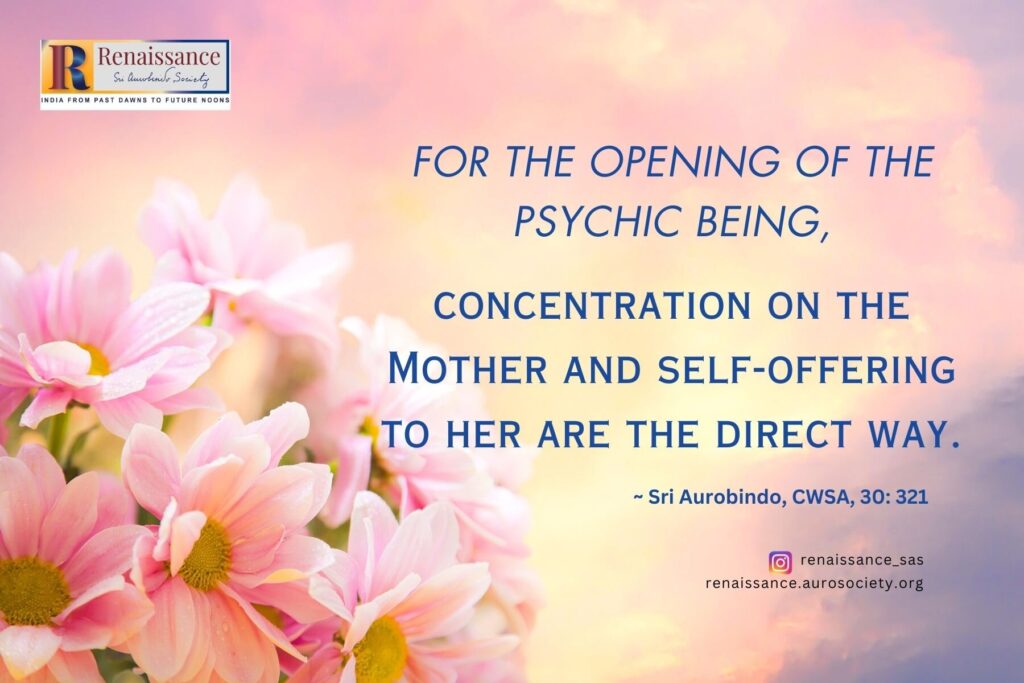
So yes, the path of sadhana is long indeed. And every step of the way, we have to pray to the Mother for Her help and grace. Ask for Her protection along the way.
The practice of Integral Yoga is based on no one particular method and can use every method. “For in his Yoga there is nothing too small to be used and nothing too great to be attempted,” (Sri Aurobindo, CWSA, Vol. 23, p. 61). One has to find what is in accordance with one’s inner temperament and soul’s turning. Whether it is the path of Knowledge, Devotion or Works, or some combination of these – the Master of Integral Yoga, the real Teacher or Guide within can take up all and guide the aspirant toward the Yoga of Perfection.
Whether it is meditating or working in the garden, sitting quietly with some elevating music playing in the background or singing some devotional songs, reading Savitri or some other volume of the Mother or Sri Aurobindo — there can be many methods to help one go within. At the core of them all is Contact with Her. If you are able to connect with the Mother through a particular method, that is your method.
Sometimes one method may feel more appropriate, at other times another. But what matters is concentrating on Her. It is through concentration one makes progress.
WATCH:
Webinar on Concentration and Progress
In the sādhanā of Integral Yoga, great emphasis is placed on inward aspiration and concentrated seeking of the Divine for Divine sake, not for some personal salvation but for the advent of a new consciousness on earth. The idea is to give maximum freedom to individual aspirants with no external pressure or demand for a certain practice.
In this light, outward practices like chanting, kirtan, worship, rituals and other such things can be important only as much as they can help us to go within. These are more as aids along the way for those who may need some or any of these. Though, of course, all of these and other outer activities when transformed with the touch of the Divine can be means for going within. Depending on the sincerity of the aspiration, they can help one to get in touch with the deepest and highest part within.
New Series: Streams of Sādhanā
To explore these and other such topics related to sādhanā on the path of Integral Yoga, we begin a new series starting with this issue of September 2023. Streams of Sādhanā – that is the title we have given to this series. Each of the streams — paths, practices, ways — must flow into the Ocean of Oneness. Sometimes they may be reduced to mere trickles, sometimes they may be billowing waves of the sea. Sometimes they may flow smoothly, sometimes there may be rocks and hurdles along the path. But as long as they continue to flow, there is progress.
Under the series Streams of Sādhanā we hope to explore selected aspects of spiritual practice and philosophy in Integral Yoga. Each issue will focus on one specific aspect, a couple of aspects will be explored over double issues. Given the vast and all-integrative nature of the Theory and Practice of Integral Yoga, only a few specific themes or areas will be taken up.
An important criterion used to identify the themes will be that these should cover both the individual and collective aspects of sādhanā. We consider it necessary because Integral Yoga, with its highest aim of bringing a Divine Life on earth, presents for the aspirants a complete path for the transformation of the individual as well as collective life. Thus, individual, nation, humanity, world, earth – all these progressively enlarging units are of concern to an aspirant on the path of Integral Yoga.
We begin the series with the theme – Concentration and Focus. As is our practice at Renaissance, we explore every theme in a multi-dimensional manner, since Integral Yoga does not leave out any aspect of life. So readers will find here our explorations into the topic of Concentration and Focus from the perspectives of spiritual sādhanā, study and mental development, overall well-being, and more.
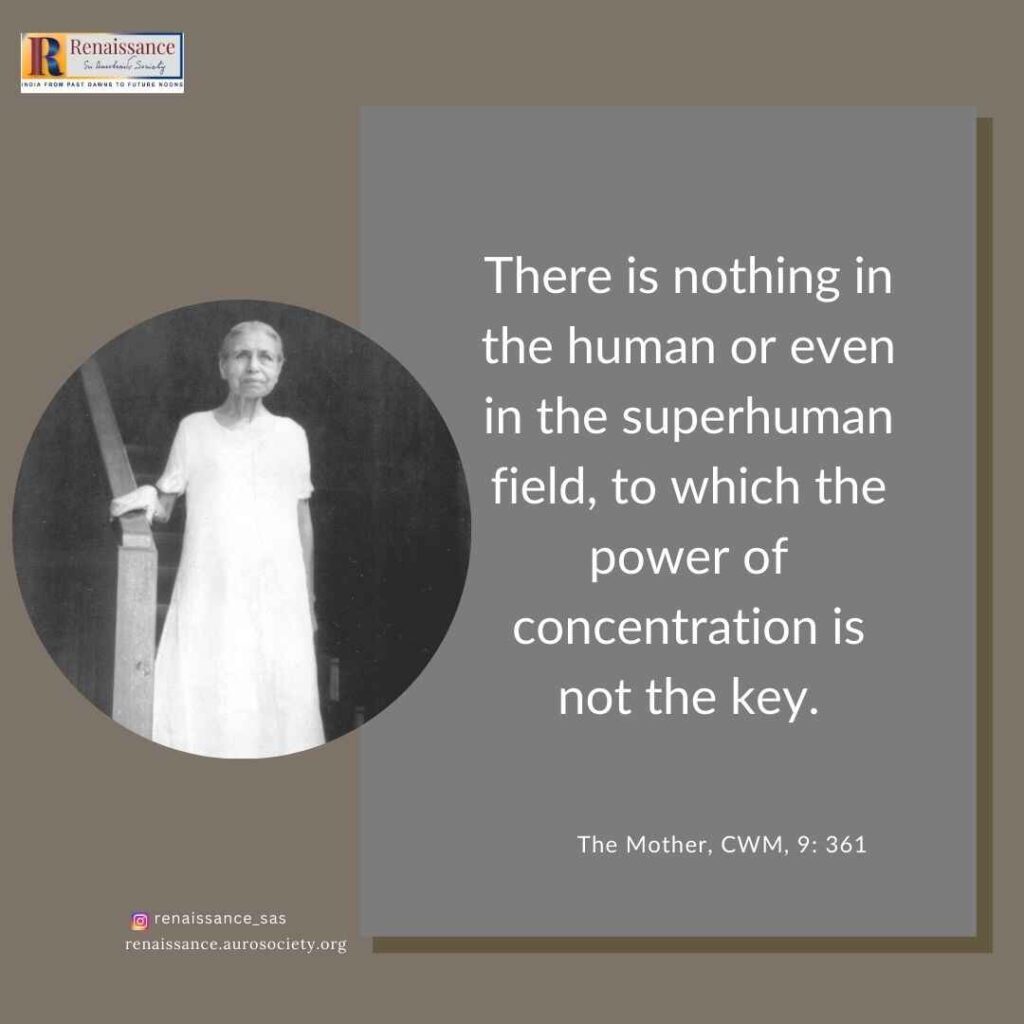
Our Offerings in this Issue
Given that concentration is such an important aspect of all spiritual pursuit and life, in the works of Sri Aurobindo and the Mother we find a great body of deep insights and detailed explanations on this. For our Guiding Light feature titled ‘Concentration in Spiritual Life‘, we present a small selection of some practical advice and guidance given by Sri Aurobindo; curious readers will be able read more at the given references.
In the feature titled ‘On Concentration, Interest and Attention‘, the selected few passages from the Mother help us learn not only what is concentration but also how to cultivate it. The Mother also emphasises the need to become conscious of the way we receive and spend our energies as well as the role of perseverance.
The passages featured in ‘Concentration and Intellectual Development‘, present the Mother’s responses to the students’ practical questions regarding learning. Whether one is trying to find solutions to mathematical problems, or is doing any scientific or artistic work, the final outcome always depends on one’s degree of concentration and the orientation of concentration. An important passage regarding the Mother’s recollection of her younger days can be helpful in guiding students on the value of concentrating on one’s work in overcoming anxiety.
We feature a few selections from Sri Aurobindo and the Mother which speak of the difference between meditation and concentration. Here we get great insights into not only the theoretical difference between the two but also on the significance of concentration for one’s spiritual growth.
Readers will also find great value in Swami Vivekananda’s thoughts on Concentration which he shared at a lecture given in San Francisco on March 16, 1900.
Narendra Murty points our attention to the the epidemic that Attention Deficit Disorder has become in his article titled ‘A Fragmented Mind in the Cyber Age‘. He reminds us how important it is to develop this capability if we aspire to achieve anything worthwhile in life, including and especially in our spiritual pursuit.
Shraddha Gour Mohanti, an educator shares some reflections based on her long teaching experience. She also gives some practical tips that can be useful for teachers looking for ways to help their students develop greater concentration ability. Runalika Roy reminds us of the immense significance of one’s capacity of concentrated attention in the overall well-being and shares some practical guidance on how to develop one’s capacity of concentrated attention.
In order to explore the problem of Concentration and Focus from a scientific point of view, Narendra Murty, Renaissance contributor and core team member, spoke to Chirasree Mitra. Ms. Mitra has a long experience of working as a psycho-social counsellor and shares some important insights based on her observations and interactions with clients and her general observations as a health professional.
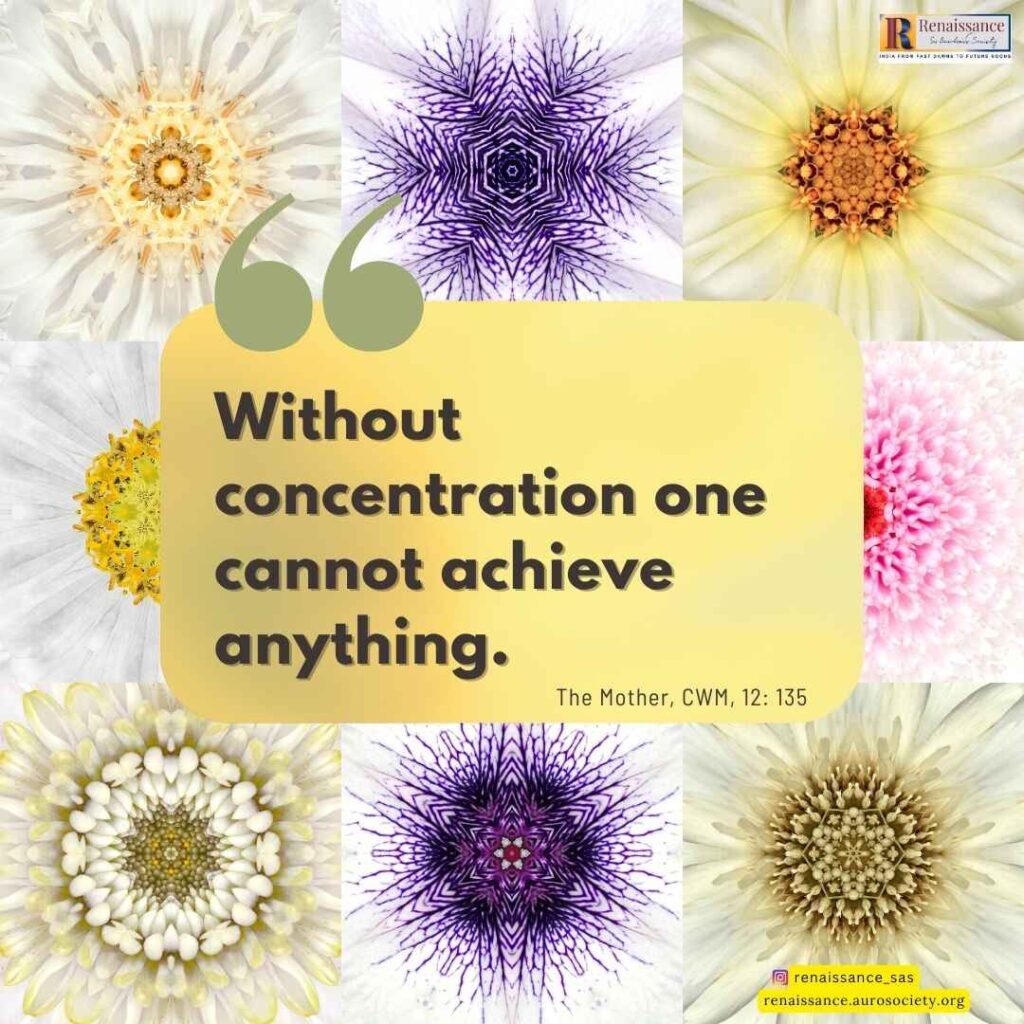
More in this Issue
As part of our year-long theme ‘Streams of Sādhanā’, we are happy to announce the start of a new series titled ‘The Upanishads Elucidated’. Through beautifully crafted stories and simple commentaries, Lopa Mukherjee is going to take readers on a journey that explores the deep wisdom, truth and beauty of the Upanishads. In every issue over the next year we will publish a story by her. Each story shall reveal a new dimension and uncover for us some deep truth from this magnificent body of sacred literature.
On August 21, 2023, the Renaissance journal team organised an insightful and thought-provoking seminar on “INDIAN-NESS IN 21st CENTURY.” Organized in collaboration with Chair of Sri Aurobindo, Pondicherry University, the seminar celebrated 150 years of Sri Aurobindo.
The event brought together scholars, cultural experts and over hundred enthusiastic students from Pondicherry University, to examine the various dimensions of Indian identity in today’s globalized world. Its main aim was to uncover and understand the importance of perception, expression or feeling of being an Indian socially, culturally and spiritually.
Click HERE to read more about the seminar.
Click HERE to view the full photo gallery.
As part of his contribution to the seminar, M. S. Srinivasan, senior research associate at Sri Aurobindo Society, wrote a thought-provoking article which beautifully elucidates the meaning of Indian-ness. We are delighted to feature it in the current issue.
As always, we offer this work at the lotus feet of Sri Aurobindo and the Mother.
In gratitude,
Beloo Mehra (for Renaissance Editorial Team)
~ Design: Beloo Mehra & Vijayatha

